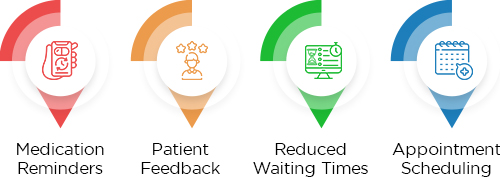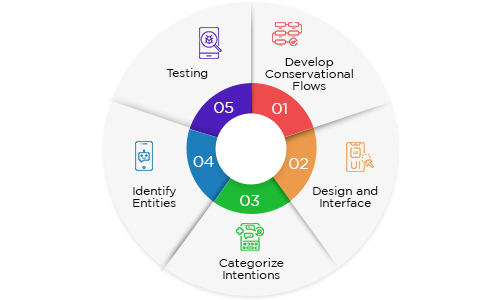Introduction
A chatbot is a software that imitates human conversation and is used by companies and service providers to conduct business communication. Although a few also have a voice interface, they mostly feature a text-based interface.
Chatbots are mainly used to conduct simple, often repetitive tasks that otherwise involve additional human staff. Companies that offer custom healthcare software solutions have been investing significantly into building healthcare chatbot development capabilities.
A healthcare chatbot is an excellent way for providers to respond to patient queries quickly and implement effective patient engagement systems. It also comes with numerous benefits for the doctors and the patients. Let’s look at some of them –
What are the Benefits of Using a Healthcare Chatbot?

1. Medication Reminders
Irregular consumption of prescribed medication is one of the biggest factors driving healthcare spending. Furthermore, being neglectful about medication is especially bad for patients suffering from heart disease, epilepsy, diabetes, etc. But a chatbot in healthcare could be a simple solution to this problem.
Users can enter their prescription details into a chatbot for patient care, including the number of pills to be taken and the time for taking them. Subsequently, it will send medication notifications to users at the right time.
In this way, chatbot applications help bolster health care management and improve patient outcomes in the long run.
2. Patient Feedback
Good patient engagement is known to have a positive effect on clinical outcomes. A useful way to foster engagement is to collect patient feedback about the quality of care and overall experience, and Healthcare chatbots provide an excellent means to do so.
Healthcare software product development has advanced to an extent where it has paved the way for comprehensively integrated healthcare solutions. Such platforms allow medical chatbots to be integrated with practice management solutions for helping providers collect valuable feedback from their patients.
Feedback helps clinicians know what the patients need and alter their services accordingly. When patients feel that their opinions are valued, it creates a bond between them and their doctors, which eventually leads to a better patient experience in general.
3. Reduced Waiting Times
Everyone loves to get answers quickly. An AI-powered chatbot solution for healthcare can answer a question in seconds. After a consultation, it’s natural for patients to have doubts about the type of tests to be taken, the results of the tests, medication, diet, and so forth. A chatbot for healthcare is a brilliant way for patients to get in touch with their providers to get their queries resolved. Without it, people generally would have to call or re-visit a clinic for advice, all of which takes time. But chatbot technology in healthcare can eliminate waiting time and the need for in-person re-visits for getting answers.
What’s better is that people who use wearable health tech can have their vitals measured in real-time and discuss them with their providers over a chatbot, and it would make for an effective remote health monitoring system. Furthermore, if integrated with advanced telehealth solutions, medical chatbots would also enable seamless, real-time communication between doctors and patients for effective remote consultation and diagnosis.
4. Appointment Scheduling
Scheduling and rescheduling appointments can get tedious for the patients and the medical staff. Mobile and web-based applications might not be user-friendly for older people who struggle with technology. But a healthcare provider chatbot that includes a feature for scheduling appointments would make scheduling as easy as typing a message.
All one needs to do is ask for an appointment and type in the desired time slot. Such functionality greatly helps in reducing missed consultations, which is known to be detrimental to health. The best part – it allows people to make appointments at their convenience.
How to Develop a Healthcare Chatbot?

1. Develop Conservational Flows
Automated healthcare solutions for chatbots must sufficiently respond to patients’ queries. As the conservation would happen through messaging, a user must feel as though they are conversing with an actual person. This requires healthcare chatbots to ensure relevance, context, and tone of replies sent to users.
Programmers must be mindful of the factors that make a text conversation meaningful. If a user types in his symptoms, the chatbot must assess them and recommend appropriate action. For, e.g., if a user complains of stomach ache with a light fever, the chatbot must recommend the proper over-the-counter medication, advice on diets, or even suggest a consultation with a physician.
A chatbot should assess the information acquired about a user’s health problems and reply appropriately with suitable suggestions. Developers usually leverage natural language processing (NLP) to help chatbots figure out the best reply for each scenario. The insights derived from medical informatics often aids in developing ideal replies to messages about symptoms.
2. Design and Interface
In this context, an interface or user interface (UI) is the mechanism for interacting with a machine. Most chatbot applications in healthcare often feature a text interface, where users must type in their questions, and some even have a voice-based interface.
Platforms such as Facebook Messenger, Telegram, and Google Assistant are highly popular among developers for designing a chatbot UI. A good interface must be easy to use for people from all walks of life – tech-savvy millennials and elders with limited technical aptitude.
3. Categorize Intentions
Chatbot applications must make interactions appear natural to ensure an ideal user experience. In other words, whenever a user begins interacting through text or voice, the application must discern context and relevancy. Subsequently, it can glean a user’s intention for using the application.
Knowing user intentions enables chatbots to give the most suitable replies, which requires natural language understanding (NLU) modules. Using these, a chatbot can classify user input into appropriate categories and figure out what they want. E.g., If a user complains of stomach ache and fever, the chatbot would suggest medication, dietary choices, or a doctor’s consultation. If the user selects either one of them, it must proceed accordingly and make the interaction meaningful.
4. Identify Entities
In healthcare chatbot development, an entity is part of user input that provides information about the user’s intention. It is vital to understand what a user needs and deliver a suitable response.
Understanding intention and entity is integral for making a chatbot conversation appear as close to a normal human conversation as possible. E.g., if a user in Chicago needs medication for stomach ache and fever, the entities would be “pharmacy,” “medicine,” and “Chicago.”
5. Testing
Testing the chatbot is the final step in healthcare chatbot development. After developing one, the programmers must test it comprehensively using all the necessary parameters. Every input must be replied to with the intended response. The accuracy of this depends upon the solution’s ability to identify, classify, and categorize intention and entity.
Conclusion
Healthcare chatbot development has witnessed significant investment and advances in the previous decade. Innovation in healthcare cloud computing has enabled medical chatbots to be accessed from any location, and it helps people who are traveling find the right kind of medical help.
Chatbots have become indispensable to patient engagement, and more providers continue to adopt them with each passing month. An effective, HIPAA compliant chatbot application is enabled by secure electronic data interchange and a user-friendly interface. As healthcare sees increasingly greater automation, it is safe to say that chatbots are here to stay.
OSP is a trusted software development company that delivers bespoke solutions as per your business needs. Connect with us to hire the best talents in the industry to build enterprise-grade software.

How can we help?
Fill out the short form below or call us at (888) 846-5382
Looking for software solutions to build your product?
Let's discuss your software solutions for your product in our free development acceleration call!
Get In Touch arrow_forwardDiscuss Your Project Handover with a team of expert Book a free consultation arrow_forward
About Author

Written by Riken Shah linkedin
Riken's work motto is to help healthcare providers use technological advancements to make healthcare easily accessible to all stakeholders, from providers to patients. Under his leadership and guidance, OSP Labs has successfully developed over 600 customized software solutions for 200+ healthcare clients across continents.

















